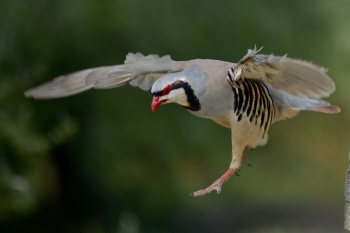- Alectoris chukar
Identification
32–39 cm (12½-15¼ in)
Adult
- Light brown back
- Grey breast
- Buff belly
- White face
- Black gorget
- Rufous-streaked flanks
- Red legs
Sexes are alike except female averages slightly smaller. Juvenile is dull brownish-gray with faint brown barring on the flanks. Outer rectrices are tinged rufous. Legs have slight reddish cast.
Similar Species
It is browner on the back and has more of a yellowish tinge to the foreneck than Rock Partridge. Red-legged Partridge lacks the gorget.
Variations
Geographical variation limited, mostly clinal, and mainly involving plumage color which may be affected by wear in the harsh arid climate. Following Gloger's rule birds in more humid areas average darker and more tinged with olive-brown on their upperparts and are more warmly colored on their underparts. Populations in more arid areas average grayer and paler, with less brown, on their upperparts and are paler on their underparts. Island populations in the Aegean Sea average smaller than those from continental populations.
Distribution
Native to Asia from Pakistan, India and Afghanistan in the east to south-eastern Europe in the west.
There have been widespread introductions which have become established in the United States, Canada, New Zealand and Hawaii.
In Great Britain, hybrids between this species and the also introduced Red-legged Partridge are common.
Status
Fluctuations in population is mainly due to the weather during the breeding season.
Taxonomy
Subspecies
There are 14 subspecies[1]:
- A. c. cypriotes: South-eastern Bulgaria to southern Syria, Crete, Rhodes, and Cyprus
- A. c. sinaica: North Syrian Desert south to Sinai Peninsula
- A. c. kurdestanica: Caucasus Mountains to Iran
- A. c. werae: Eastern Iraq and south-western Iran
- A. c. koroviakovi: Eastern Iran to Pakistan
- A. c. subpallida: Tajikistan (Kyzl Kum and Kara Kum mountains)
- A. c. falki: North-central Afghanistan to Pamirs and western China (western Xinjiang)
- A. c. dzungarica: North-western Mongolia to Russian Altai and eastern Tibet
- A. c. pallescens: North-eastern Afghanistan to Ladakh and western Tibet
- A. c. pallida: North-western China (Tarim basin of western Xinjiang)
- A. c. fallax: North-western China (eastern and southern Tien Shan Mountains of Xinjiang)
- A. c. chukar: Eastern Afghanistan to eastern Nepal
- A. c. pubescens: Inner Mongolia to north-western Sichuan and eastern Qinghai
- A. c. potanini: Western Mongolia
Habitat
This is a resident breeder in dry, open, and often hilly country.
Behaviour
Action
When disturbed, they prefer to run rather than fly, but if necessary will fly a short distance when they show rounded wings.
Breeding
The clutch contains between 8 and 20 eggs. They are laid in a ground scrape with minimal lining.
Diet
They have a wide and varied diet, which consists of bulbous roots, grain and shoots of grass and cereals, berries. They also eat insects and including their eggs.
Vocalisation
The song is a noisy chuck-chuck-chukar-chukar.
References
- Clements, J. F., T. S. Schulenberg, M. J. Iliff, D. Roberson, T. A. Fredericks, B. L. Sullivan, and C. L. Wood. 2018. The eBird/Clements checklist of birds of the world: v2018. Downloaded from http://www.birds.cornell.edu/clementschecklist/download/
- McGowan, P.J.K. & Kirwan, G.M. (2019). Chukar (Alectoris chukar). In: del Hoyo, J., Elliott, A., Sargatal, J., Christie, D.A. & de Juana, E. (eds.). Handbook of the Birds of the World Alive. Lynx Edicions, Barcelona. (retrieved from https://www.hbw.com/node/53380 on 24 April 2019).
- Christensen, G. C. (1996). Chukar (Alectoris chukar), version 2.0. In The Birds of North America (A. F. Poole and F. B. Gill, Editors). Cornell Lab of Ornithology, Ithaca, NY, USA. https://doi.org/10.2173/bna.258
Recommended Citation
- BirdForum Opus contributors. (2025) Chukar Partridge. In: BirdForum, the forum for wild birds and birding. Retrieved 27 April 2025 from https://www.birdforum.net/opus/Chukar_Partridge
External Links
GSearch checked for 2020 platform.1







